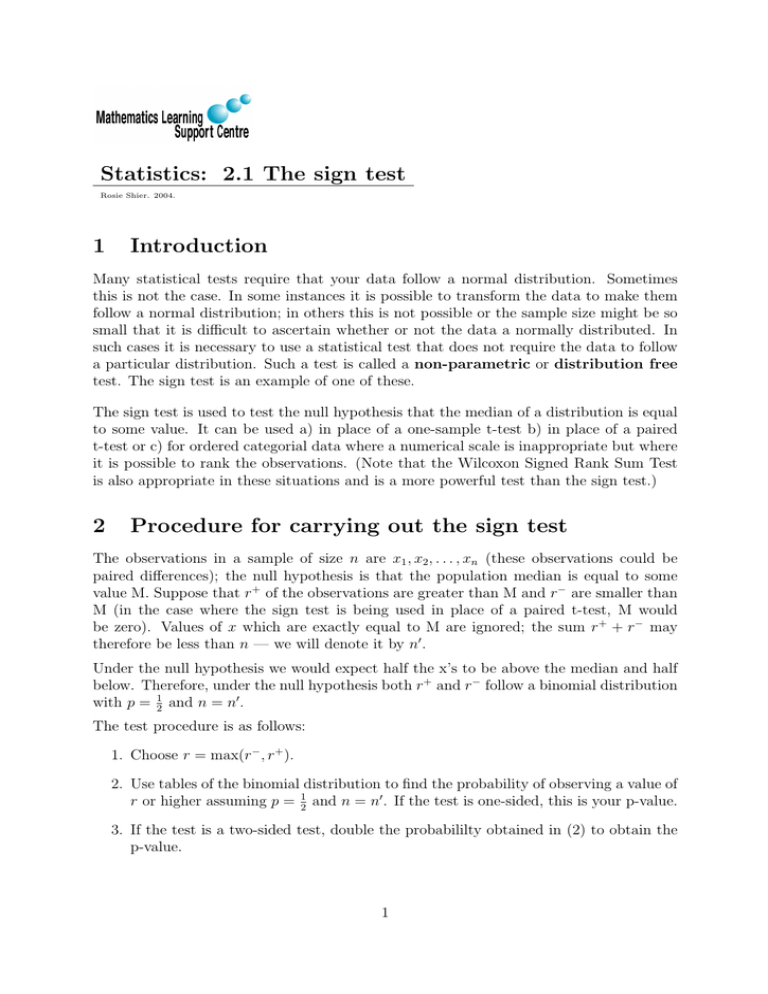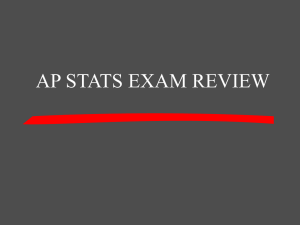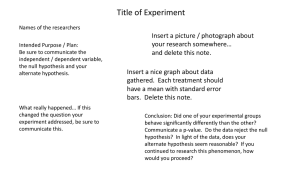2.1 The sign test
advertisement

Statistics: 2.1 The sign test Rosie Shier. 2004. 1 Introduction Many statistical tests require that your data follow a normal distribution. Sometimes this is not the case. In some instances it is possible to transform the data to make them follow a normal distribution; in others this is not possible or the sample size might be so small that it is difficult to ascertain whether or not the data a normally distributed. In such cases it is necessary to use a statistical test that does not require the data to follow a particular distribution. Such a test is called a non-parametric or distribution free test. The sign test is an example of one of these. The sign test is used to test the null hypothesis that the median of a distribution is equal to some value. It can be used a) in place of a one-sample t-test b) in place of a paired t-test or c) for ordered categorial data where a numerical scale is inappropriate but where it is possible to rank the observations. (Note that the Wilcoxon Signed Rank Sum Test is also appropriate in these situations and is a more powerful test than the sign test.) 2 Procedure for carrying out the sign test The observations in a sample of size n are x1 , x2 , . . . , xn (these observations could be paired differences); the null hypothesis is that the population median is equal to some value M. Suppose that r+ of the observations are greater than M and r− are smaller than M (in the case where the sign test is being used in place of a paired t-test, M would be zero). Values of x which are exactly equal to M are ignored; the sum r+ + r− may therefore be less than n — we will denote it by n0 . Under the null hypothesis we would expect half the x’s to be above the median and half below. Therefore, under the null hypothesis both r+ and r− follow a binomial distribution with p = 21 and n = n0 . The test procedure is as follows: 1. Choose r = max(r− , r+ ). 2. Use tables of the binomial distribution to find the probability of observing a value of r or higher assuming p = 12 and n = n0 . If the test is one-sided, this is your p-value. 3. If the test is a two-sided test, double the probabililty obtained in (2) to obtain the p-value. 1 Example: The table below shows the hours of relief provided by two analgesic drugs in 12 patients suffering from arthritis. Is there any evidence that one drug provides longer relief than the other? Case Drug A Drug B Case Drug A Drug B 1 2.0 3.5 7 14.9 16.7 2 3.6 5.7 8 6.6 6.0 3 2.6 2.9 9 2.3 3.8 4 2.6 2.4 10 2.0 4.0 5 7.3 9.9 11 6.8 9.1 6 3.4 3.3 12 8.5 20.9 Solution: In this case our null hypothesis is that the median difference is zero. Our actual differences (Drug B - Drug A) are: +1.5, +2.1, +0.3, −0.2, +2.6, −0.1, +1.8, −0.6, +1.5, +2.0, +2.3, +12.4 Our actual median difference is 1.65 hours. We have r+ = 9, r− = 3, n = 12, r = max(r− , r+ ) = 9. Therefore our two-sided p-value (from binomial tables) is p = 0.146. We would conclude that there is no evidence for a difference between the two treatments. Note that the Wilcoxon Signed Rank Sum Test would also be appropriate in this case and is a more powerful test because it takes account of the magnitude of the differences as well as the sign. 3 Carrying out the sign test in SPSS Case 1: Paired data — Choose Analyze — Select Nonparametric Tests — Select 2 Related Samples — Specify which two variables comprise your pairs of observation by clicking on them both then clicking on the arrow to put them under Test Pair(s) List. — Under Test Type select Sign — Click on OK The output will look like this: Frequencies Drug B - Drug A a Negative Differences Positive Differencesb Tiesc Total N 3 9 0 12 a. DRUGB < DRUGA b. DRUGB > DRUGA c. DRUGA = DRUGB 2 Test Statisticsb DRUGB - DRUGA Exact Sig. (2-tailed) 0.146 a. Binomial distribution used. b. Sign Test If you were carrying out a one-sided test, you would need to divide the p-value by 2. Case 2: Single set of observations Note that in this case SPSS includes values that are exactly equal to the median — it takes r+ = the number of observations that are greater than M and r− = the number of observations that are less than or equal to M. Any ties should therefore be excluded manually as follows: choose Data then Select Cases; choose If condition is satisfied and click on If ; in the box type in your variable name then 6= M , where M is the median value specified in your null hypothesis; click on Continue then OK and proceed as detailed below. — Choose Analyze — Select Nonparametric Tests — Select Binomial — Choose the relevant variable as the Test Variable — Under Define Dichotomy in the lower left hand corner of the pop-up screen, choose Cut Point and specify your null value (i.e. 0 in the case of paired data, etc.) — Click on OK The output will look like this: Binomial Test Category Drug B - Drug A Group 1 Group 2 Total ≤0 >0 N Observed Test Prop. Exact Sig. Prop. (2-tailed) 3 0.25 0.50 0.146 9 0.75 12 1 If you were carrying out a one-sided test, you would need to divide the p-value by 2. 3





